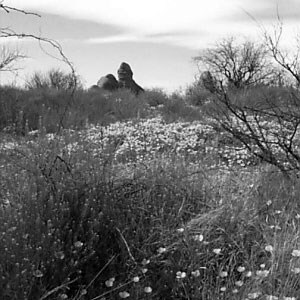
By Ginny Sphar
Father Juan was born in Caravaca, Spain, in 1670. He began his novitiate in 1688 and professed his final vows on the Sonora frontier in 1704. He crossed the Atlantic from his native province of Murcia, Spain, as a lad of 18 or so years and had entered the Society of Jesus in Mexico City.[1] He had requested and been granted a missionary assignment. Father San Martín came to Guevavi in the period of summer rains. In 1701 he reached the Pimería Alta. Due to muddy trails and the flooded washes, he was forced to stay at San Ignacio, 65 miles south of Guevavi. If only the cursed rain would let up he would get on with it. But “because nothing happens by chance as far as God is concerned,” he wrote to Father Kino on June 30, 1701, “He arranged my detention so that I might receive the letter of Your Reverence and learn from it the great kindness Your Reverence shows me by offering to assist me with everything necessary for the new villages to which holy obedience summons me.[2] There were good reasons why Guevavi as made the cabacera instead of San Cayetano de Tumacácori. There were more natives at Guevavi and it was more centrally located. A padre could minister with little difficulty to the natives of the three other native settlements, San Cayetano, San Luis and Los Reyes. By 1701, Guevavi was made the cabacera and an operating Jesuit mission. “The Father for whom they asked,” was on his way. Practically nothing is known about San Martín, Guevavi’s first resident Jesuit, except for what little Kino chose to tell. With Kino’s assistance, Father San Martín got off to a good start. “At Guevavi in a few months we finished a small but neat house and church, and we laid the foundation for a large church and house.”[3] Every day the natives saw Father San Martin. Every day he and his assistants, likely misionized Yaquis or Opatas, told them what they should or what they should not do to better themselves and their mission. The village hechiceros cannot have been pleased when they found their magic curtailed or forbidden. Yet these natives of Guevavi, whom later Jesuits accused of being haughty, lazy and ungrateful, were, according to Father Kino, docile, hard working and desirous of becoming Christians. Father San Martín lasted only a few months. On the evening of November 4, 1701, Father Kino found the Padre’s house vacant. Sickness among the Jesuits of Guevavi was to become traditional; San Martín’s case was the first of many. If he returned it was only briefly.[4] When Father Kino, in the spring of 1704, rode down to Guaymas, it was Father San Martín who greeted him and showed him "a thousand kindnesses at the villages of San Francisco and La Santísima Trinidad del Pitiquín near present day Hermosillo.[5] For ten years or so lFather San Martín seems to have left the frontier. By 1726 he was back and serving as minister at Arivechi in east-central Sonora. He stayed there for eleven more years where he was accused by Father Christobál Lauria, his immediate supervisor, of being a gossip monger. On his way to Mexico City in 1737 to become Father Procurator for the province, Father Juan fell off his horse and badly injured his leg. Ten years later, at the Jesuit College of Espiritu Santo in Puebla, he died on December 8, 1748.[6] The natives of Guevavi and Bac had lost their first resident priest, but they still had Father Kino. In the fall of 1702 or 1703, Kino rode through Guevavi and Tumacácori on the way to build a large church at Bac.[7] Everywhere along the route he looked after the spiritual and temporal matters of the natives. Kino was now 57 and slowing down. This was probably his last trip north. Father Kino died in 1711 at Magdalena, on March 15. For 10 years before his death and 20 years after, the natives of Guevavi seldom saw a Padre. [1] Father Juan de San Martín was born in Caravaca, Spain, in 1670. He began his novitiate in 1688 and professed his final vows on the Sonora frontier in 1701. Alberto Francisco Pradeau and Burrus, “Los Jesuitas en Sonora,” unpublished manuscript, Los Angeles, 1965. [2] San Martín to Kino, San Ignacio, June 30, 1701, quoted in Kino, “Favores Celestiales,” II, 2, XIII. [3] Kino, “Favores Celestiales,” ibid. [4] If he did come back to his first mission, Father San Martín, seeking more healthful surroundings, may have chosen to live in Tumacácori. A listing of memorias, annual financial statements and requests for goods, submitted by the Padres in 1702 cited one from Cayetano. “Extracto de lo conducenté a la demanda sobre Sinodos de Misiones.” AGN, Misiones, 22. [5] Kino, “Favores Celestiales,” III, 3, VI and VIII. [6] Pradeau and Burrus, “Los Jesuitas.” In two vitriolic letters to the Father Provincial, San Martín seemed to be settling accounts with Father Rector Lauria and the other Italian Padres. San Martín to Father Joseph Barba, Arivechi, Sept. 10 and Nov. 21, 1735; Archívo Histórico de Hacienda, México, D.F. (AHH), Temporalidades (Temp.), legajo 17, microfilm, BL. [7] Kessell says 1702. Dr. Felipe de Jesús Valenzuela says 1703. |
Last updated: May 6, 2025
